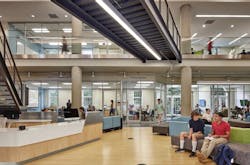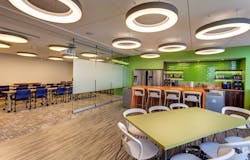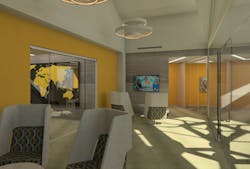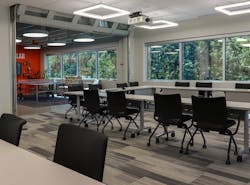I came to Hanbury in 2017, after designing and managing workplace interiors projects for more than a decade. So naturally, I've observed the higher ed students we design for through a slightly different lens—not just as students but as the next generation of knowledge workers. I can't help but think of how their unique behaviors and preferences will shape the workplaces to come.
Communication and Connection
Generation Z is heavily influenced by technology. Technology, although cultivating broad social and cultural connections through social networks, also sometimes creates isolation. In the learning environment, face to face interaction is key in developing a sense of commonality, purpose and learning. Collective learning, where students are taught to learn through group engagement helps to create a sense of community and adds to diversity of thought and experience. In keeping with this trend in the education sector, collaboration has also become the preferred method of working. Physical engagement and the "making of things" has become the foundation of educational process. Students gather with their peers in groups ranging from clusters of three to five and sometimes larger. When in large group learning, the group sizes ebb and flow as members break off into clusters to focus and engage, creating spontaneous interactions and opportunities for engagement, periodically rejoining the larger group for discussion.
Spaces that support this transitional collaboration require flexibility to turn large spaces into small spaces, and to connect small spaces into larger spaces. These amorphous spaces work best as casual environments that empower people to move and use furniture in ways that suit their particular needs at that moment.
Companies should consider furnishing office workspace with groupings of comfortable and easily movable pieces that can accommodate both smaller clusters and large groups. These spaces should also have plenty of opportunities to plug in as these gatherings often gravitate to where power is available. Depending on the nature of the work, places where clusters of people can mock up, prototype, and test their ideas might also be useful.
Seamless Technology
The education environment today is both physical and virtual. In universities today, I would wager that most students would consider YouTube as their secondary learning environment. Online classes and supplemented learning is increasingly common. Recent graduates are accustomed to taking their digital preferences and work progress with them from device to device, from office to car to home. Due to easy access to digital information, continual learning and augmented learning of class material outside the classroom is the norm. Just as students are learning everywhere, the young knowledge worker will have a fluid relationship with where work is done and information is acquired.
The cloud and the Internet of Things (IOT) are increasingly important to young workers. Hoteling desks feel instantly personalized when lighting, chairs and other connected devices automatically adjust to their pre-set preferences. As technology continues to improve, interconnected devices that read one's preferences, condition, location and interest will become ubiquitous in the work and home environment. Access to information from different devices and sources, untethered to a physical space, creates new opportunities for learning.
Places to Think and Play
Turning inward for reflection, alone time and even recreation is part of the Gen Z culture. In large open spaces, students use headphones and goggle monitors (for Augmented Reality) to provide private focus in public environments, either for work or play. While accommodating the gaming preferences of young staffers may not be appropriate in a work setting, privacy is important. Small spaces separated by glass provide privacy and noise reduction while allowing a visual connection to what is happening in the collaborative spaces.
Work life balance is a driving force for Generation Z. The office is looked at as a place to gain autonomy, learning, social engagement and purpose. The trend to create spaces of play is being substituted with places of creativity, where making things and collaboration are promoted. Corporate recreation lounges of today may become less and less attractive as younger employees look to their offices as unique opportunities for work and cultural interactions. Greater emphasis on wellness, both physically and emotionally is driving the next generation outside of the office into proximal public settings (at a 3rd place) for social interaction, e.g. clubhouses, restaurants, gyms or neighborhoods with co-workers and other creatives and peers from the broader community. Companies may find more value in locating their office in active areas of town versus allocating space for foosball, ping-pong, and pool tables.
Connection to Nature
The Z Generation is part of the Green Generation. Personal values, including health, lifestyle and environmental stewardship help to define the passions and interest of this burgeoning group. To young workers, there is an inherent value in sunlight, natural materials and sustainable lifestyles. On campuses, dark rooms and spaces without natural light are left vacant while students flock to the naturally lit spaces. Furniture will be pulled right up to the windows in order to work along side a view, or in the warmth of the sun. Companies will find that spaces with physical and visual access to the outdoors are prime real estate ideal for communal spaces. Low-cost means of connecting to nature through natural materials, vegetation, imagery and even colors are solid investments.
The youngest of our workforce today bring with them the values and processes they learned and practiced in the university setting; collaboration, accessibility, sustainability, creativity, and egalitarianism. They seek fulfillment and purpose in the work they do and are eager to learn and be led in that pursuit. Workspaces can communicate these values in subtle ways while also supporting business goals. The key to office design is to connect to the human needs of the staff, while creating an environment that reinforces the values of the business.
About the Author
Hanbury
Hanbury's Knowledge Cafe is features the latest intelligence about architecture and planning for universities and colleges. Accessible articles are authored by Hanbury leaders and address key industry issues and trends--the topics that university and college administrators and facility leaders are tackling as they plan, build, renovate, and maintain the campuses that serve the 21st-century students, faculty, and staff. Follow us on Facebook, Instagram, LinkedIn, and Twitter.




